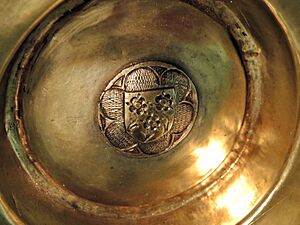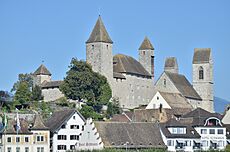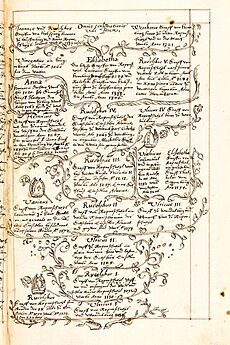Elisabeth von Rapperswil facts for kids
Elisabeth von Rapperswil (born around 1261, died 1309) was a very important noblewoman. She was the last countess from the original House of Rapperswil. Through her second marriage, she made sure that her family's large lands in the area called Zürichgau stayed with her descendants.
Her son from her first marriage was Wernher von Homberg. He was a powerful official called a Reichsvogt. Her oldest son from her second marriage was Count Johann von Habsburg-Laufenburg. He passed on the title of Count of Rapperswil to his own son, Johann II.
Contents
Elisabeth's Early Life
Elisabeth von Rapperswil was likely born around 1261. Her home was probably Rapperswil Castle in the city of Rapperswil. Her mother was Mechthild von Neifen. Her father was Rudolf III von Vaz. His mother, Adelheid, was from the House of Rapperswil.
When the previous Count Rudolf III died in 1255, Elisabeth's father started calling himself Count Rudolf IV von Rapperswil. Elisabeth had two brothers, Vincent and Rudolf V. Sadly, Vincent died young. Rudolf V died when he was only 18.
In 1261, Elisabeth's father made an important decision. He wrote a document saying that certain lands given by the Einsiedeln Abbey would go to Elisabeth. Other lands would go to his wife, Mechthild. This showed how important Elisabeth was to her family's future.
Around 1276, Elisabeth married Count Ludwig von Homberg. They had two children. Their son, Wernher von Homberg, became a powerful Reichsvogt (a kind of royal governor). Their daughter, Cecilia von Homberg, became the leader (abbess) of the Oetenbach Nunnery.
Becoming Countess of Rapperswil
In 1289, Elisabeth's husband, Ludwig von Homberg, died in a battle. This meant Elisabeth became the Countess of the Grafschaft Rapperswil. A Grafschaft was a county, a land ruled by a count or countess.
After Ludwig's death, Elisabeth had to make some tough choices. In 1290, she sold some of her family's rights and lands in Uri to the Wettingen Abbey.
Elisabeth was a friend and ally of the city of Zürich. She even had Burgrecht with Zürich. This meant she had special citizenship rights there. She also supported the Oetenbach Nunnery in Zürich. Her daughter, Cecilia, was the leader there and helped it grow.
In 1291, Countess Elisabeth made an agreement with the city of Zürich. They formed an alliance for three years against the Dukes of Austria-Habsburg. This showed her political skill.
In 1296, Elisabeth married for a second time. Her new husband was Count Rudolf of Habsburg-Laufenburg. They had several children, including Johann I, Rudolf, Ludwig, and Clara.
Elisabeth was very important in guiding the county of Rapperswil. She was in charge from 1289 to 1309. The male line of her family ended in 1283 when her younger brother, Rudolf V, died. After his death, King Rudolf I of Habsburg took control of some Rapperswil lands.
Elisabeth had to sell some of her personal lands in 1286 to the Rüti Abbey because of money problems. In 1290, she sold more property in Uri. This is why she joined forces with Zürich in 1291. She was trying to protect her family's power against the powerful Habsburg family.
As a ruler, Elisabeth signed many important documents. She settled disagreements and gave rights to different towns. For example, in 1300, she gave the knight Hermann II von Landenberg control of Greifensee. This included the castle, the town, and the lake. It also included many farms and the rights to the courts in Uster.
In 1303, Elisabeth divided the county of Rapperswil. The lands on the left side of Zürichsee went to her children from her first marriage. The lands on the right side stayed with the Habsburg-Laufenburg family, her second husband's family. This decision was made even though King Albrecht did not agree with it.
Death and Legacy
Elisabeth von Rapperswil likely died on April 10, 1309, at Rapperswil Castle. She might have been buried in the Wurmsbach nunnery near the Obersee lake. The graves of her younger brother and mother were found there. However, Elisabeth's grave has not been found yet.
After her death, her husband, Count Rudolf, made a donation to the Wettingen Abbey. He did this for the good of his parents, his late wife Elisabeth, and himself.
In 1310, Elisabeth's husband Rudolf and her son Johann I made another important donation. They gave money to the church in Jonen in Rapperswil. This money was to pay for a priest to hold services on Sundays and holidays. They did this to honor their ancestors and Elisabeth.
What Happened Next
After Count Rudolf von Habsburg-Laufenburg died, Elisabeth's son, Johann I, inherited the Rapperswil lands and rights. Johann I died in 1337 in a battle. His son, Johann II, then took over.
Johann I and Johann II were against Rudolf Brun, who became the mayor of Zürich in 1336. In 1350, a rebellion in Zürich failed. As a result, the city of Rapperswil and the Rapperswil and Altendorf castles were largely destroyed by Brun's army.
Count Johann II was put in prison in Zürich for two years. He and his younger brothers had to sell most of their remaining property to the Dukes of Austria. They needed the money to rebuild their ruined castles and lands.
See also
- House of Rapperswil
- Johann I (Habsburg-Laufenburg)
- Johann II (Habsburg-Laufenburg)
Literature
- Erwin Eugster: Adlige Territorialpolitik in der Ostschweiz. Kirchliche Stiftungen im Spannungsfeld früher landesherrlicher Verdrängungspolitik. Zürich 1991, ISBN: 3-90527-868-5.
- Roger Sablonier: Gründungszeit ohne Eidgenossen: Politik und Gesellschaft in der Innerschweiz um 1300. hier + jetzt, Baden 2008, ISBN: 978-3-03919-085-0.




